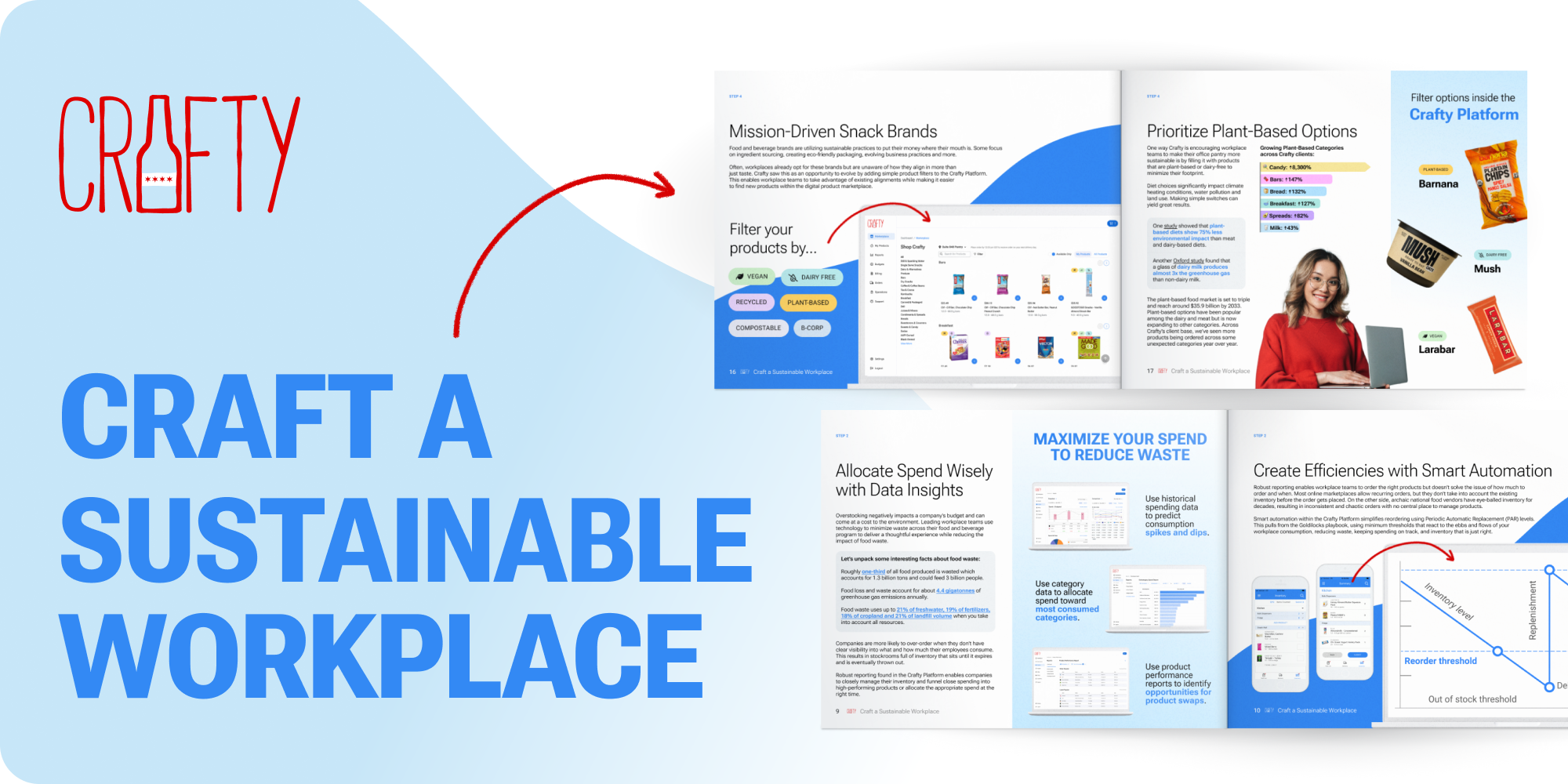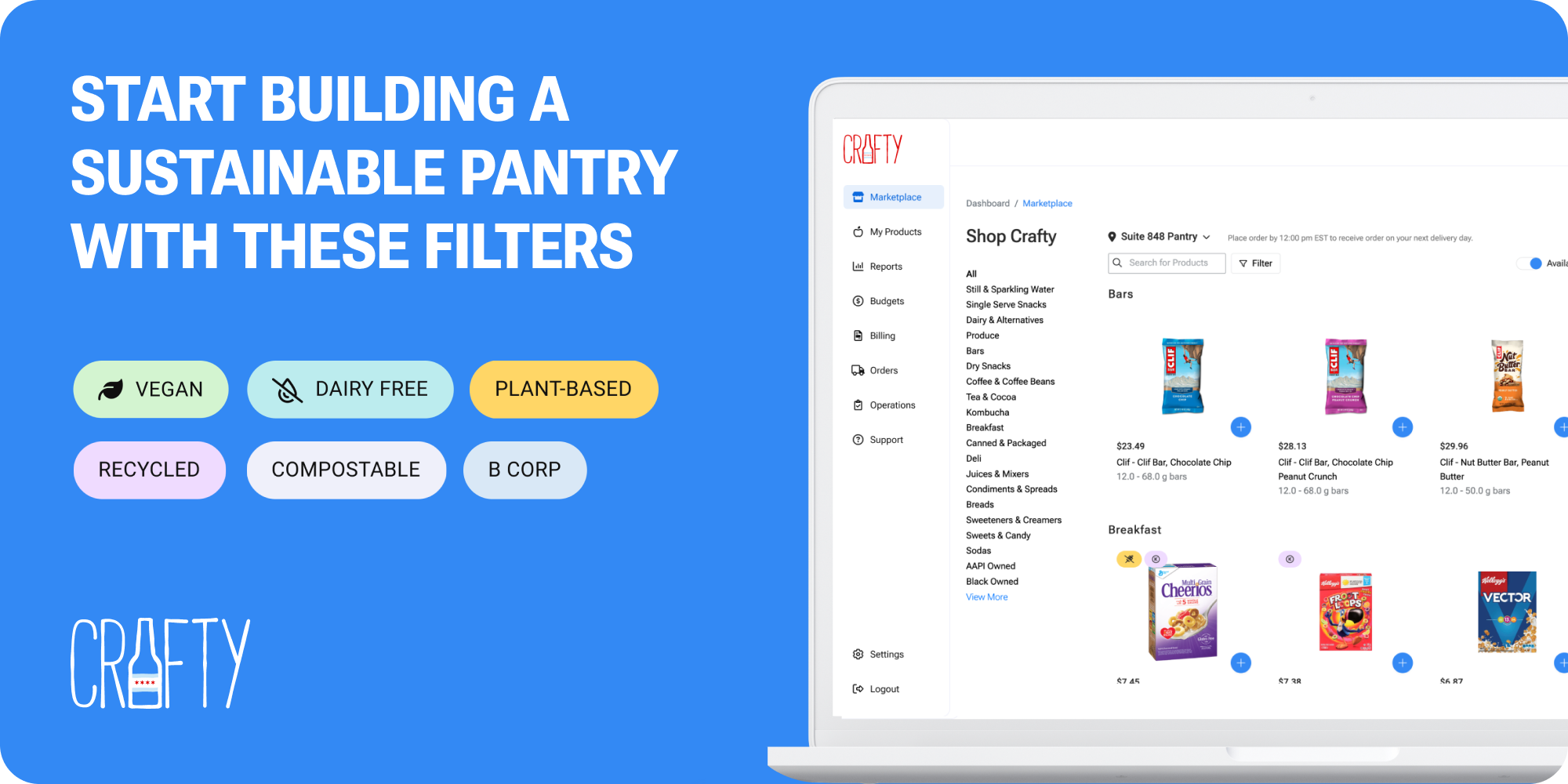Five Steps to Craft a Sustainable Pantry
Build a sustainable pantry that aligns with values while creating efficiencies.

Sustainability is so ingrained in modern society that when we hear it, we can often disregard it as just a buzzword. In reality, sustainable initiatives are extremely important to employees and executives alike.
- Employee Level: A recent IBM study reported that 75% of employees say they want to
see their employers take action on social responsibility issues. - Executive Level: McKinsey & Company recently reported that 53% of chief investment officers identified sustainability as a competitive advantage and a key factor in deciding whether to buy or hold a financially healthy company.
Sustainability is not just a fleeting trend. Adopting sustainable practices within your workplace experience, and more specifically within your food and beverage program, is a way to hit both audiences.
Dive into the key elements that make up a sustainable office pantry program:
- What's the difference between proactive vs. reactive sustainability practices?
- What are the key trends we are seeing across top workplaces?
- What are the five steps to a sustainable pantry program?
- Step 1: Consolidate your office pantry orders.
- Step 2: Minimize waste with insightful reporting.
- Step 3: Swap your equipment to prioritize bulk options.
- Step 4: Choose better products that prioritize sustainability.
- Step 5: Add on additional environmental programs.
🚨 NEW REPORT
CRAFT A SUSTAINABLE WORKPLACE
Explore the five practices leading workplaces use to build sustainable office pantry programs.
Reactive Sustainable Practices
You're probably already familiar with reactive sustainable practices such as recycling. This category concerns what we do with waste once it's been created so it has less of an impact on the environment. Reactive practices can include:
- Recycling
- Upcycling
- Composting
Proactive Sustainable Practices
This category is the one most aren't as familiar with. Instead of focusing on what we do with waste, we focus on how to create less of it in the first place. Proactive practices can include:
- Consolidating orders
- Streamlining inventory
- Swapping to bulk products
- Choosing brands that practice sustainability
Every company focuses on reactive efforts, but smart companies are proactive. The goal is to minimize as much waste as possible while still delivering a high-quality experience. To do this, you need the tools to order thoughtfully, spend responsibly and adjust accordingly so employees can feel good about treating themselves in the workplace.
What are the key trends we are seeing across top workplaces?
Investing in sustainability is important not just to employees but also to long-term business success. The World Economic Forum reported that investment in environmental change tripled in 2023. This shift was driven by growing awareness among business leaders of the significant returns on investment sustainability initiatives could yield.
Companies are seeing how climate change is resulting in the rising costs of goods and are making swaps now to minimize future disruptions. A recent Gartner study found that 80% of business leaders see sustainability programs as a way to help their organizations optimize operations and reduce costs.
Capgemini Research Institute discovered that 50% of organizations believed technology is the key to accomplishing sustainability goals. Plus, they reported that investing in streamlined tools can drive more cost efficiencies while considerably reducing greenhouse gas emissions and energy consumption.
Explore five steps the expert Crafty team uses to craft sustainable office pantries across the globe.
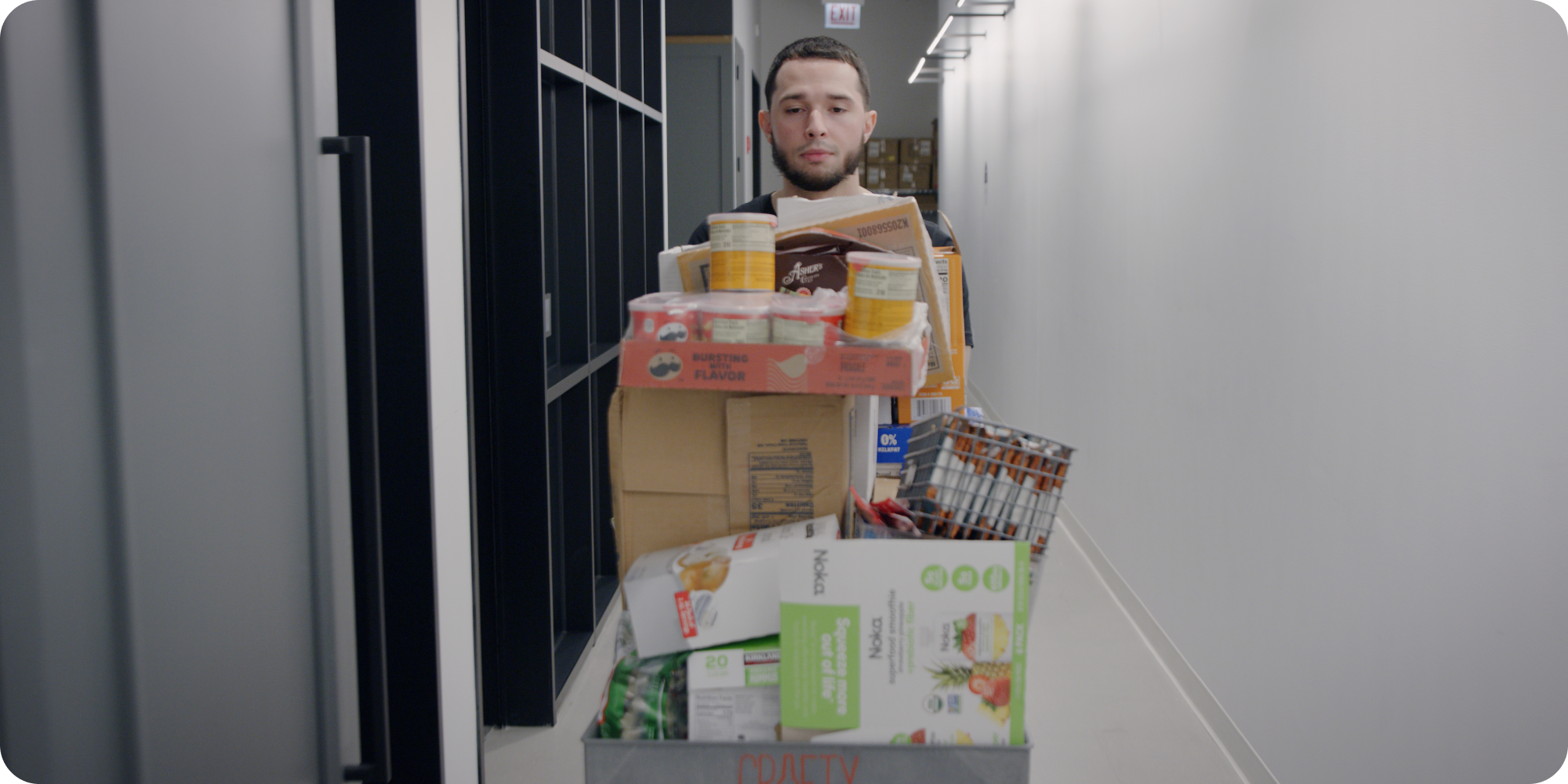
Online marketplaces may be convenient, but this ordering style, especially in bulk, can have a devastating result. When you order from online marketplaces like Amazon or Instacart, your products are often shipped from a variety of locations while using lots of packaging. The approach has a snowball effect when it comes to waste.
Amazon generated 71.54 million metric tons of carbon dioxide equivalent last year, a 40% increase within 2 years.
A company like Amazon ships well over a million packages every single day in the United States (1.6 million as of April 2024). When you break it down, this comes out to:
- 66,000 packages per hour
- Over 1,000 per minute
- An order every 20 seconds
Top workplaces reduce this waste across their locations by centralizing their program management. Companies like Crafty allow workplaces to manage multiple locations via a central platform while leveraging local fulfillment partners to minimize the impact of long-distance shipping and additional packaging.
FEATURED SPOTLIGHT:
.png?width=529&height=92&name=Sprout%20Social%20Crafty%20Case%20Study%20(1).png)
"Crafty has made a significant [sustainable] impact by providing compostable and recyclable supplies and signage to educate our people. It's helped us fold sustainability into our workplace in an approachable way"

Overstocking negatively impacts a company's budget and can come at a cost to the environment. Want to hear a few frightening statistics?
- Roughly one-third of all food produced is wasted, which accounts for 1.3 billion tons and could feed 3 billion people.
- The US alone wastes 92 billion pounds of food annually.
- Food loss and waste account for about 4.4 gigatonnes of greenhouse gas emissions annually.
- Food waste uses up to 21% of freshwater, 19% of fertilizers, 18% of cropland and 21% of landfill volume when you take into account all resources.
YIKES! Do you want one-third of the total pantry spend to go down the toilet? Of course not! Companies are more likely to over-order when they don't have clear visibility into what and how much their employees consume. This results in stockrooms full of inventory that sits until it expires and is eventually thrown out. Using technology to solve for sustainability not only saves the planet, but could save your budget.
The Crafty Platform helps workplaces find solutions:
- Use historical spending data
to predict consumption spikes and dips. - Use category data to allocate spend toward the most consumed categories.
- Use product performance reports to identify opportunities for product swaps.
- Use order automation to set minimum thresholds so you only order what you need.
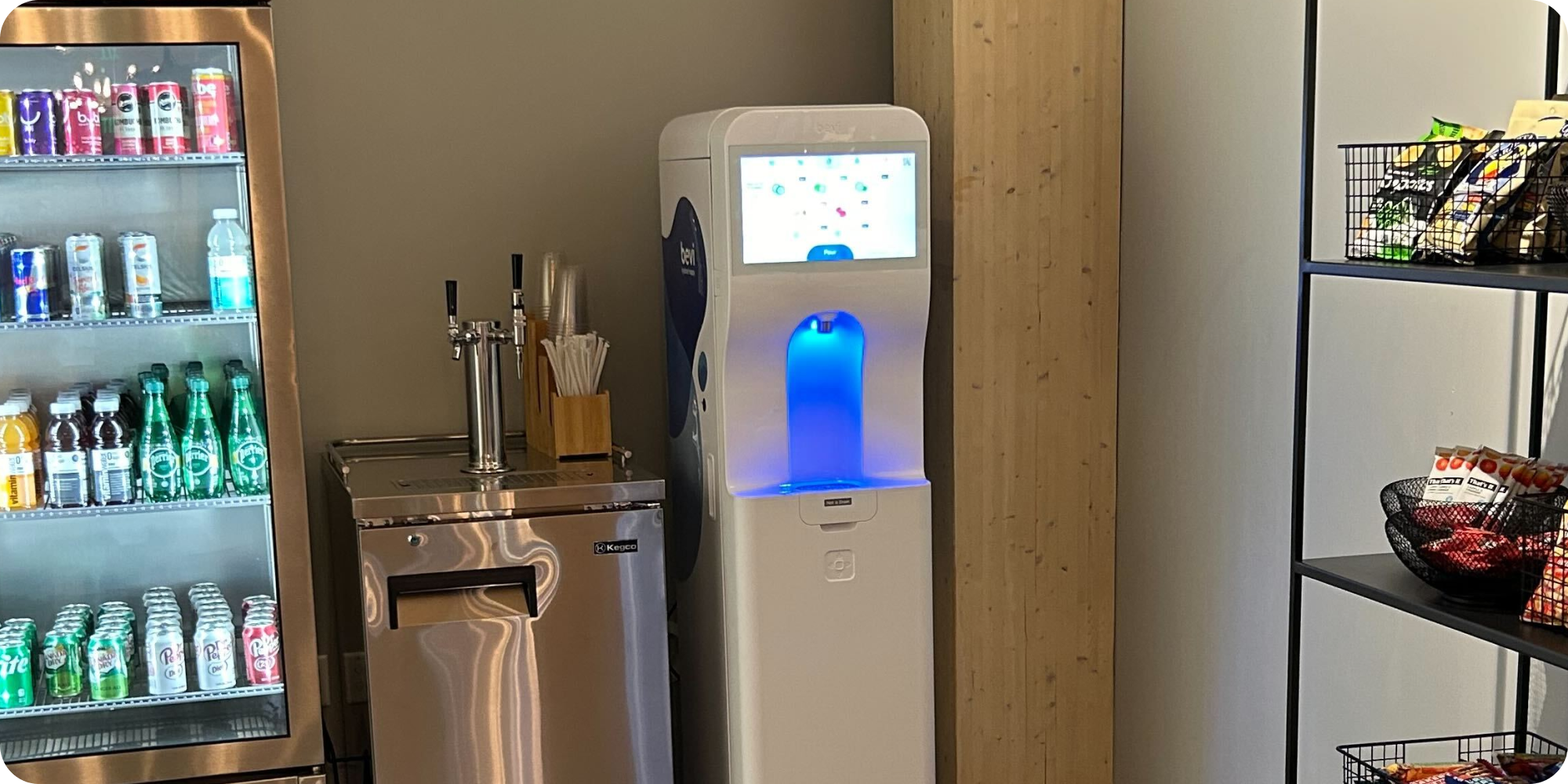
Hydrating your workforce is a priority, especially in the summer months, but all those cans and bottles can add up quickly. Investing in the right hydration equipment is a great way to give employees what beverages they want while being kind to the environment.
Here are some examples of beverages and snacks that can be enjoyed in bulk with the right equipment:
- Kegs:
- Coffee
- Kombucha
- Water Dispensers:
- Still Water
- Sparkling Water
- Flavored Water
- Snack Dispensers:
- Cereal
- Nuts
- Dried Fruits
- Candy
Water machines like Bevi offer still, sparkling, and flavored options. They are a great way to save thousands of plastic bottles and aluminum cans. You can give employees the power of personalization, save money, and minimize your environmental impact.
According to Crafty data across 300+ offices:
- 1.7m plastic bottles have been saved across Crafty clients in 2023
- 47% increase in Bevi machine refills
- The Bevi flavor Peach Mango was the most popular in 2023
Our reports have shown us that Bevi machines can pour up to 90 glasses of water per hour and save roughly $45,000 per year on average for an office of 500 people. This is just one example of how easy it is to swap out your equipment in favor of sustainable options.
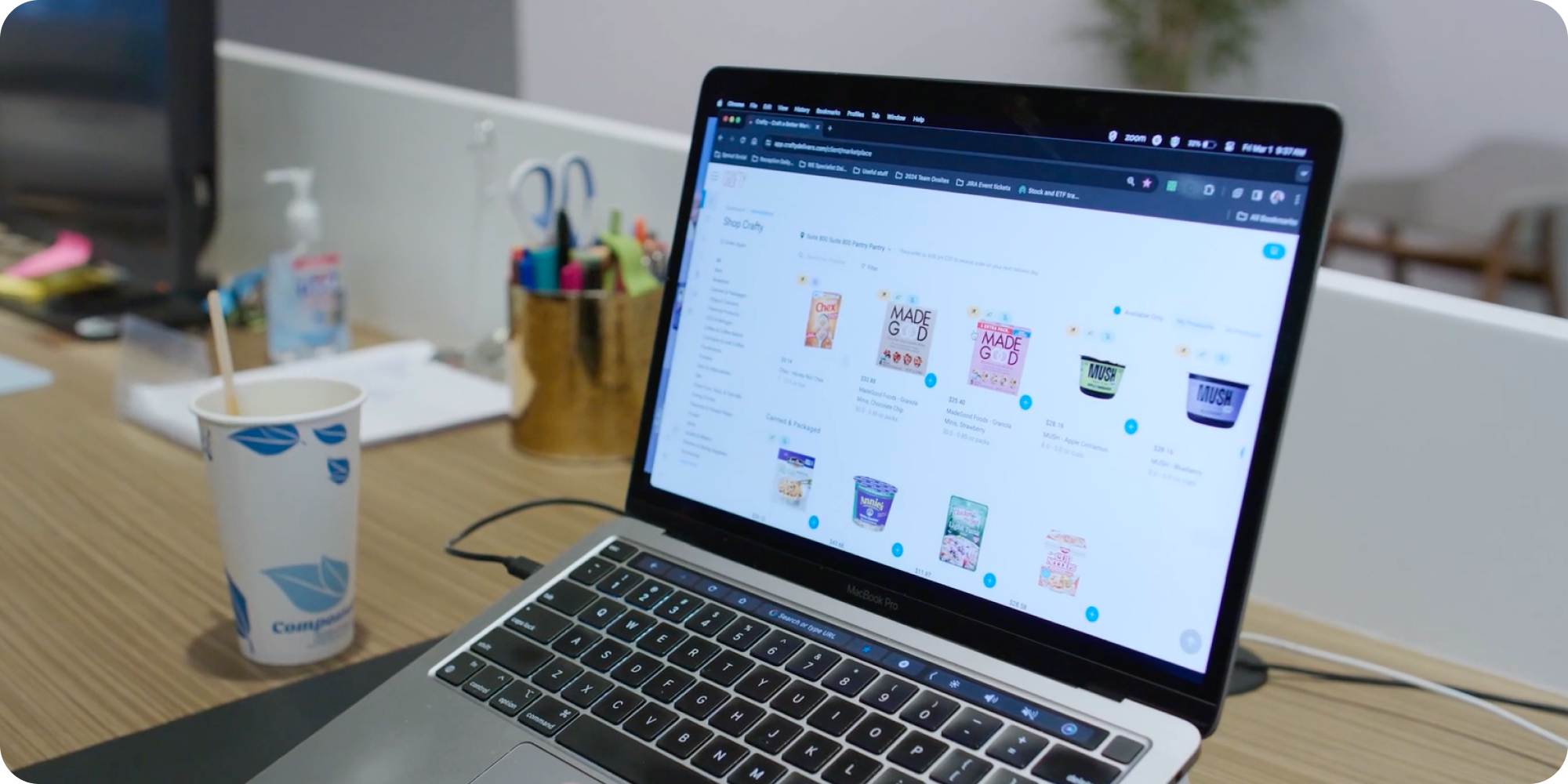
When thinking about what to stock your office pantry with, there are countless brands to choose from. For example, in the world of chocolate, you have Hershey's, Cadbury, and Ghirardelli (if you're a little boujee). Finding the brands that align with your goals is the key to designing a sustainable pantry.
Many food and beverage brands are utilizing sustainable practices to put their money where their mouth is. These brands focus on ingredient sourcing, creating eco-friendly packaging, evolving business practices, and more that all prove fruitful for the environment:
- Plant-based snacks show 75% less environmental impact than meat or dairy-based snacks.
- Plastic makes up 52% of consumer packaging worldwide, yet when brands switch to alternative materials, they decrease their carbon footprint by 42% on average.
- Compostable office kitchen and pantry supply units increased by 68% across Crafty clients in 2023. Compostable product production requires less energy than traditional materials like plastics.
Often, workplaces already opt for these brands but are unaware of how they align in more than just taste. Crafty saw this as an opportunity to evolve by adding simple product filters to the Crafty Platform. This enables workplace teams to take advantage of existing alignments while making it easier to find new products within the digital product marketplace.
Sustainable filters include:
- B Corp
- Plant-Based
- Compostable
- Dairy-Free
- Vegan
- Recycled
SUSTAINABILITY
The Best Sustainable Products for Your Office Pantry
From vegan to B Corp brands, the Crafty Platform makes finding products that align with your sustainability goals easy.
Read More >
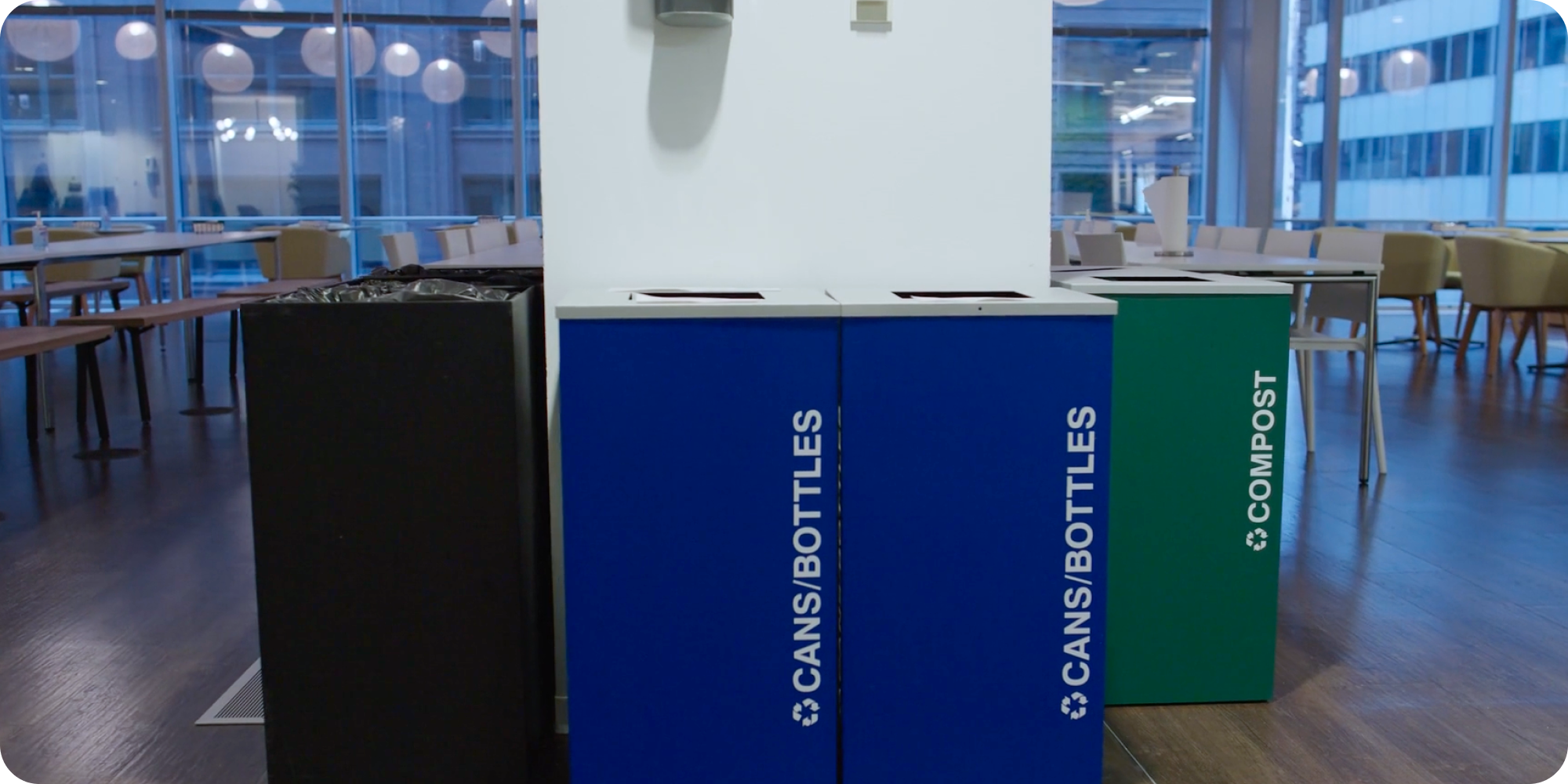
One person's trash is another's treasure. That is unless someone accidentally throws a recyclable product into the garbage, which is something that Bloomberg recently discovered that 76% of Americans do. Remembering what can be recycled and what cannot is sometimes difficult, and so TerraCycle was created to solve this problem.
With Terracycle, only one bin exists, and when waste is taken out of the office and to the TerraCycle plant, it is immediately sorted and redistributed to ensure maximum reuse.
There have been 7,225,040,939 items recycled across TerraCycle users since the company's inception
Another option is composting. We've all seen compost bins outside of suburban homes, so why not have one in the office? Composting is nature’s way of recycling. Our offices here at Crafty have composted 947 lbs of products since we introduced compost bins to our employees.
Conclusion
So, there you have it. Five easy ways to craft a sustainable office pantry. It is the small changes that often have the largest effect. When clients come to us for workplace sustainability advice, we remind them of three things:
- Invest in smarter equipment and programs aligned with what your employees are consuming on a daily basis.
- Align your product selection with brands committed to sustainable initiatives like yours.
- Streamline your operations to reduce waste with powerful technology platforms (like Crafty).
If you’d like to learn more about how Crafty can help you build a sustainable pantry, reach out to the team and schedule a call. Be proactive, not reactive. 😉
Cillian Dunne and Rebecca Ross
CRAFT
A BETTER
WORKPLACE?
Elevate your office food and beverage program with enhanced services managed in one innovative, centralized platform.

